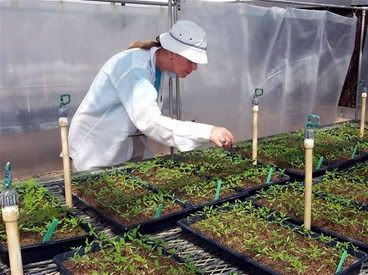By Bruce Bugbee
INTRODUCTION
In preparation for writing this paper, I read the related papers from previous HSA proceedings. I am impressed by the amount of useful information. The annual meeting and proceedings of HSA have become an important source of technical information on the hydroponic culture of plants. This information is not necessarily available at the annual meetings of related professional societies such as The American Society for Horticultural Science, or The American Society of Agronomy.
It was necessary for me to read other papers because many of them discuss nutrient management in recirculating hydroponic systems. Authors at every meeting in the past 5 years have stressed the need to recirculate and reuse nutrient solutions to reduce environmental and economic costs. Dr. Pieter Schippers (1991 HSA proceedings) reviewed nutrient management and clearly indicated the need for data when he said, "One of the weakest points in hydroponics...is the lack of information on managing the nutrient solution." I was moderately surprised to find that previous authors recommended measuring the concentrations of individual nutrients in solution as a key to nutrient control and maintenance. Monitoring ions in solution is unnecessary. Even worse, the rapid depletion of some nutrients often causes people to add toxic amounts of nutrients to the solution. Monitoring solutions is interesting, but it is not the key to effective maintenance.
MANAGING NUTRIENTS BY MASS BALANCE
During the past 12 years, we have managed nutrients in closed hydroponic systems according to the principle of "mass balance," which means that the mass of nutrients is either in solution or in the plants. We add nutrients to the solution depending on what we want the plant to take up.
Plants quickly remove their daily supply of some nutrients while other nutrients accumulate. This means that the concentrations of nitrogen, phosphorous, and potassium can be at low levels in the solution (0.1 mM or a few ppm) because these nutrients are in the plant, where we want them. Maintaining a high concentrations of nutrients in the solution can result in excessive uptake that can lead to nutrient imbalances.
For example, the water removed from solution through transpiration must be replaced and it is necessary to have about 0.5 mM phosphorous in the refill solution. If the refill solution was added once each day, the phosphorous would be absorbed by the plant in a few hours and the solution phosphorous concentration would be close to zero. This does not indicate a deficiency, rather it indicates a healthy plant with rapid nutrient uptake. If the phosphorous level is maintained at 0.5 mM in the recirculating solution, the phosphorous concentration in the plant can increase to 1% of the dry mass, which is 3 times higher than the optimum in most plants. This high phosphorous level can induce iron and zinc deficiency (Chaney and Coulombe, 1982).
Feeding plants in this way is like the daily feeding of a pet dog, some dogs would be far overweight if their food bowls were kept continuously full.
Nutrient Management in Recirculating Hydroponic Culture
7:53 PM
ThanateTan







